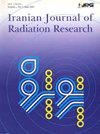Efficacy of mathematical models in predicting the concentration of indoor radon in areas with high levels of natural background radiation
Q4 Health Professions
引用次数: 1
Abstract
Background: Indoor levels of Rn in some residential areas in Ramsar are as high as 31,000 Bq/m3, resulting in mean internal exposures up to 71 mSv/y. The main goal of this study was to develop a simple mathematical model for predicting radon concentrationfrom gamma radiation level in dwellings located in high background radiation areas (HBRAs) and a nearby normal background radiation area (NBRA) of Ramsar. Materials and Methods: The levels of gamma background radiation and indoor radon were measured in 350 dwellings located in normal and high background radiation areas (210 dwellings from HBRAs and 140 dwellings from NBRAs). Moreover, data about the most important environmental factors such as temperature and humidity as well as the inhabitants’ nutrition were collected. Results: The mathematical relationship between the gamma radiation level and indoor radon concentration in NBRAs and HBRAs is introduced in this study. The findings obtained in this study clearly indicate that in normal and high background radiation areas of Ramsar the majority of confounding factors such as the type of building materials and ventilation in different houses are almost identical. Therefore, the level of gamma radiation can be used as a strong predictive tool for radon concentration. Conclusion: As radon concentration in indoor air strongly varies with time, the simple mathematical methods developed in this study, can help health physicists and environmental scientists have an estimate of the mean radon level in these areas.数学模型在高自然背景辐射地区室内氡浓度预测中的有效性
背景:拉姆萨尔一些居民区的室内Rn水平高达31000 Bq/m3,导致平均内部暴露量高达71 mSv/y。本研究的主要目标是开发一个简单的数学模型,用于根据拉姆萨尔高本底辐射区(HBRA)和附近正常本底辐射区域(NBRA)住宅的伽马辐射水平预测氡浓度。材料和方法:测量了位于正常和高背景辐射区的350户住宅(210户来自HBRA,140户来自NBRA)的伽马背景辐射和室内氡水平。此外,还收集了有关最重要的环境因素的数据,如温度和湿度以及居民的营养状况。结果:介绍了NBRA和HBRA中γ辐射水平与室内氡浓度的数学关系。这项研究中获得的结果清楚地表明,在拉姆萨尔的正常和高背景辐射区,大多数混杂因素,如建筑材料的类型和不同房屋的通风,几乎是相同的。因此,伽马辐射水平可以作为氡浓度的有力预测工具。结论:由于室内空气中氡浓度随时间变化很大,本研究开发的简单数学方法可以帮助健康物理学家和环境科学家估计这些地区的平均氡水平。
本文章由计算机程序翻译,如有差异,请以英文原文为准。
求助全文
约1分钟内获得全文
求助全文
来源期刊

Iranian Journal of Radiation Research
RADIOLOGY, NUCLEAR MEDICINE & MEDICAL IMAGING-
CiteScore
0.67
自引率
0.00%
发文量
0
审稿时长
>12 weeks
期刊介绍:
Iranian Journal of Radiation Research (IJRR) publishes original scientific research and clinical investigations related to radiation oncology, radiation biology, and Medical and health physics. The clinical studies submitted for publication include experimental studies of combined modality treatment, especially chemoradiotherapy approaches, and relevant innovations in hyperthermia, brachytherapy, high LET irradiation, nuclear medicine, dosimetry, tumor imaging, radiation treatment planning, radiosensitizers, and radioprotectors. All manuscripts must pass stringent peer-review and only papers that are rated of high scientific quality are accepted.
 求助内容:
求助内容: 应助结果提醒方式:
应助结果提醒方式:


